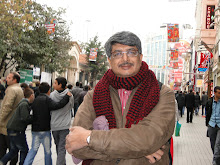Temperatures were appreciably lower at Diraphuk and I felt the cold seep in as the evening faded into twilight and the dark. Thank God for my "Down Jacket", I was reasonably comfortable inspite of an occasional shiver than ran through me like an electric current.
Gale type winds blew through as we tried to sleep on cold mattresses in our rooms. With the almost full moon shining brightly through a cloudless sky, the Northern Face looked dark, forbidding and majestic. The ice crown at the very top reflected the cool moon light and it looked like a jewel of the Gods.
We had to leave early the next day, well before dawn. After a simple breakfast, we set out at seven and it was dark. Had to walk a kilometre or so before we came across a small rickety bridge over a stream. Just some wooden logs nailed together...some village engineer made this possible.
The climb to Dolma La pass begins soon after this. It is a stiff climb a 1000 metre climb spread over a distance of four - five kilometres. The pony team started of and we brave souls started our long trudge to the top. This was no ordinary climb as the path was full of boulders and the walking strip meandered between them. Up we went step by step and every twenty steps we needed to stop for a break. The Russians were superbly fit and they scampered up as if they were walking in a park. The Brit not to be left behind set his own pace. That left three stragglers who were bringing up the rear and falling behind...(hahaha).
Somewhere after three hundred metres our climb was getting shorter and rest periods were getting longer. It was a constant battle in my mind...listen to my body and opt for a pony to climb upto the peak (some seven hundred metres) or stick to my stand of walking (my ego, I guess). The three of us finally opted for the pony to get us to the peak. That was a welcome change as I gaped in awe at the terrain ahead. It was very steep, full of huge boulders and very uneven. It was indeed very arduous. The nomads who manage these horses were used to all this and would climb without a break.
I confess that, somewhere deep within, I was a trifle disappointed but had to acknowledge that my body was not fit enough for this. I had not practised for this back home.
We reached the Dolma La pass at above 19,000 feeti in just about forty five minutes. That is where the pony drops us and off it goes back. The sky was overcast and it was very cold. This is considered a holy spot and all Tibetans would prostrate at this spot and pray. They also have a curious custom of leaving behind something that is valuable to them. People had left behind clothes, prayer flags, prayer rosaries, a lock of hair, some jewellery and other personal belongings. This signified their detachment from material things.
The guides requested us not to spend much time at the top. The cold and altitude are fickle and can turn dangerous at any moment. We set out from there in about ten minutes, now on foot till the end. The descent was sharp, almost vertical at places and large boulders were intricately laid out like steps.
We passed Gauri Kund on the way. A small pond in a valley about 500 metres below our path, was supposed to be Goddess Parvati's bathing spot and many believe that this is the spot where Ganpati was born.
Further ahead was a rock formation on top of a mountain that resembled an axe. This is known as the "Axe of Karma" or "Lekyi Ta ra".
The descent was more hopping on these boulders than walking. After hopping down literally 1000 metres, we reached the valley floor. There were a few tents and it was time to open our dry lunch packs. After a longish rest, it was time to set off to Zulthulpuk, our spot for overnight stay. The terrain was level with a river flowing in the valley. We kept to the right of the river. Though level, we had a few boulders to jump over, many small streams to cross, trudge through grasslands, a few small hills to climb. It took me about three hours or so to cross those ten + kms to our tenting spot.
We had pitched tents a few kilometres before Zulthulpuk. Spotting those blue tents from a distance was a great relief and as I reached, my first act was to gulp down an entire bottle of water. Suitably rehydrated, it was time for some hot "chai and nashta".
We had to leave early the next day, well before dawn. After a simple breakfast, we set out at seven and it was dark. Had to walk a kilometre or so before we came across a small rickety bridge over a stream. Just some wooden logs nailed together...some village engineer made this possible.
The climb to Dolma La pass begins soon after this. It is a stiff climb a 1000 metre climb spread over a distance of four - five kilometres. The pony team started of and we brave souls started our long trudge to the top. This was no ordinary climb as the path was full of boulders and the walking strip meandered between them. Up we went step by step and every twenty steps we needed to stop for a break. The Russians were superbly fit and they scampered up as if they were walking in a park. The Brit not to be left behind set his own pace. That left three stragglers who were bringing up the rear and falling behind...(hahaha).
Somewhere after three hundred metres our climb was getting shorter and rest periods were getting longer. It was a constant battle in my mind...listen to my body and opt for a pony to climb upto the peak (some seven hundred metres) or stick to my stand of walking (my ego, I guess). The three of us finally opted for the pony to get us to the peak. That was a welcome change as I gaped in awe at the terrain ahead. It was very steep, full of huge boulders and very uneven. It was indeed very arduous. The nomads who manage these horses were used to all this and would climb without a break.
I confess that, somewhere deep within, I was a trifle disappointed but had to acknowledge that my body was not fit enough for this. I had not practised for this back home.
We reached the Dolma La pass at above 19,000 feeti in just about forty five minutes. That is where the pony drops us and off it goes back. The sky was overcast and it was very cold. This is considered a holy spot and all Tibetans would prostrate at this spot and pray. They also have a curious custom of leaving behind something that is valuable to them. People had left behind clothes, prayer flags, prayer rosaries, a lock of hair, some jewellery and other personal belongings. This signified their detachment from material things.
The guides requested us not to spend much time at the top. The cold and altitude are fickle and can turn dangerous at any moment. We set out from there in about ten minutes, now on foot till the end. The descent was sharp, almost vertical at places and large boulders were intricately laid out like steps.
We passed Gauri Kund on the way. A small pond in a valley about 500 metres below our path, was supposed to be Goddess Parvati's bathing spot and many believe that this is the spot where Ganpati was born.
Further ahead was a rock formation on top of a mountain that resembled an axe. This is known as the "Axe of Karma" or "Lekyi Ta ra".
The descent was more hopping on these boulders than walking. After hopping down literally 1000 metres, we reached the valley floor. There were a few tents and it was time to open our dry lunch packs. After a longish rest, it was time to set off to Zulthulpuk, our spot for overnight stay. The terrain was level with a river flowing in the valley. We kept to the right of the river. Though level, we had a few boulders to jump over, many small streams to cross, trudge through grasslands, a few small hills to climb. It took me about three hours or so to cross those ten + kms to our tenting spot.
We had pitched tents a few kilometres before Zulthulpuk. Spotting those blue tents from a distance was a great relief and as I reached, my first act was to gulp down an entire bottle of water. Suitably rehydrated, it was time for some hot "chai and nashta".





2 comments:
This is one great adventure tale with a holy twist!
Water was the sweetest we ever drank, the chai the best ever
thank you once again
Post a Comment